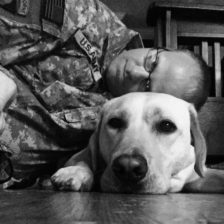April is the month of the military child. This commemoration began in 1986 when former Defense Secretary Caspar Weinberger established this designation.
Some kids earn and are known by the term “military brat.” If you are known or know someone by this term, they have simply moved around the country (or in and out of the country) with their parents. These kids are resilient. They have the strength to handle just about anything.
Military children deal with deployments, parents who might be in and out of the home, frequent moves, and sometimes the injuries that their parents may face from their time served.
While my own children may not be “military brats,” they certainly know what life is like with a Veteran. They have learned “on the go” or “hands on” throughout our relationship with Sam. When they first met Sam, I remember explaining to them that he was a Veteran. While they understood that to a certain extent, they had never really encountered someone who served, let alone who had multiple deployments and worked with Veterans on a daily basis.
We learned things quickly about Sam and the behaviors we saw at home and in public. Crowds were just not a thing for Sam. He held on bravely at school events, theme parks, and softball tournaments. Going to restaurants sometimes required a seat change, or a shift around the table so Sam would be comfortable. There were even moments of Sam mentioning things to the kids like “please don’t walk up behind me” or “please don’t stand over my shoulder.”
What I started to realize as the mom (and girlfriend, eventual fiance and wife) is that while Sam has served, my kids are now serving in a way too. They are secondary caregivers. Caden often asks Sam about his medication, how he is feeling, and if he is okay in certain environments. Kirsten can spot when Sam might feel uncomfortable at a large event, and sometimes has a bit of social anxiety too.
Kids pick up on things: behaviors, ticks (bouncing leg, figety hands, rocking back and forth–or body language). There are kids who know when their parent has had enough, and there are kids who know simply to just not ask questions. Kids are becoming part of the caregiving role in order to help out their families, or in some cases learn more about their parent who might be suffering from invisible or visible injuries.
There are more than 1.88 million military children in our world. There are around 1, 177, 972 active duty military children between the ages of 0-22 in various parts of the world as well. We can do our part to support these children and their families by understanding the roles that these kids and their families play in the part of military service.
We have to also consider those children of military Veterans as well. While some may have not served while their parents were serving, they are in a role now that enables them to learn about their parents or Veterans service. This is a role my children are in. While they also learn about service, they have learned first hand about sacrifice.
We have encountered PTSD moments. Family vacations that have gone awry. Separation from Sam at large events where there are just too many people, and sometimes, even with Memphis, the kids can recognize when the situation might be too much.
In those moments come some education. We have to talk about some things that tend to change Sam’s behavior, we have to talk about situations that might make him uncomfortable, and while they may not understand all that war can do to someone, they learn how to manage and make things comfortable for our family. They become secondary caregivers, and they become stronger, more resillient to situations that they may not even want to face.
So, on April 10 you can “Purple Up!” for military kids by wearing purple or showing support for this kids who may have to grow up a little quicker than normal, for the kids who live with one parent while the other is deployed, for the kids who move from state to state and have to endure making new friends each time, and you can support their families by learning more about military children and families.
Check out these resources to learn more:
https://sesamestreetformilitaryfamilies.org/
http://www.aasa.org/MilitaryChild.aspx



Awsome!